mirror Oldsmobile Cutlass 1998 Owner's Manuals
[x] Cancel search | Manufacturer: OLDSMOBILE, Model Year: 1998, Model line: Cutlass, Model: Oldsmobile Cutlass 1998Pages: 348, PDF Size: 17.46 MB
Page 65 of 348
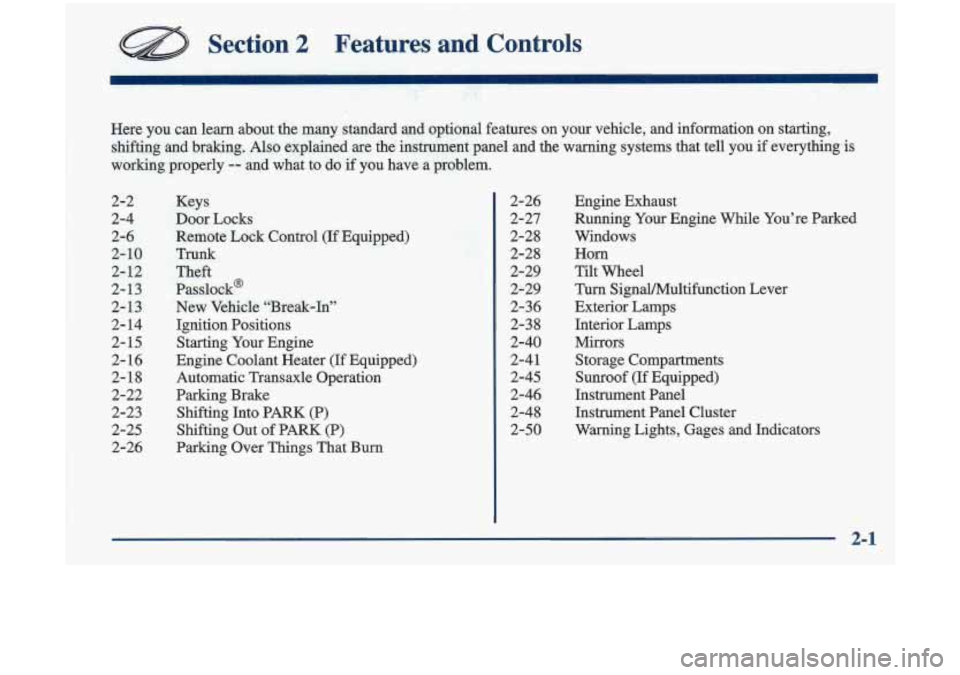
Section 2 Features and Controls
Here you can learn about the many standard and optional features on your vehicle, and inform\
ation on starting,
shifting and braking. Also explained are the instrument panel and the warning systems that tell you
if evewng is
working properly
-- and what to do if you have a problem.
2-2 2-4
2-6
2- 10
2- 12
2- 13
2-13
2- 14
2- 15
2- 16
2-18
2-22
2-23 2-25
2-26
Keys
Door Locks
Remote Lock Control
(If Equipped)
TrWnk
Theft Passlock'
New Vehicle "Break-In" Ignition Positions
Starting Your Engine
Engine Coolant Heater
(If Equipped)
Automatic Transaxle Operation
Parking Brake
Shifting
Into PARK (P)
Shifting Out of PARK (P)
Parking Over Things That Bum 2-26
2-27
2-28 2-28
2-29
2-29
2-36
2-38
2-40
2-4
1
2-45
2-46
2-48
2-50 Engine Exhaust
Running
Your Engine While You're Parked
Windows
Horn
Tilt Wheel
Turn Signal/Multifimction Lever
Exterior Lamps Interior Lamps
Mirrors Storage Compartments
Sunroof (If Equipped)
Instrument Panel Instrument Panel Cluster
Warning Lights, Gages and Indicators
2-1
Page 103 of 348
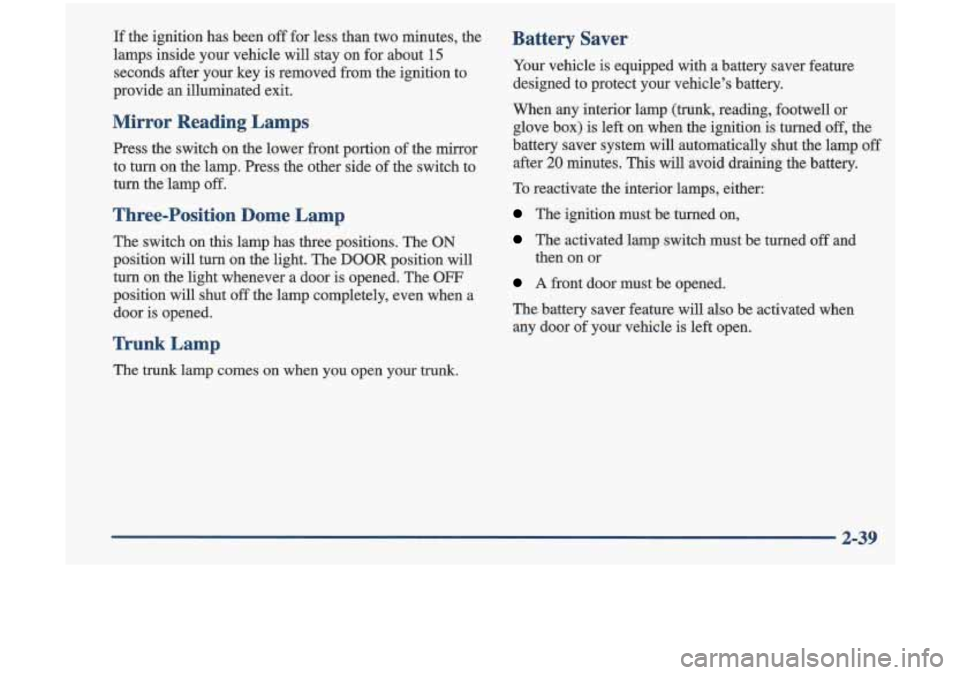
If the ignition has been off for less than two minutes, the
lamps inside your vehicle will stay on for about
15
seconds after your key is removed from the ignition to
provide
an illuminated exit.
Mirror Reading Lamps
Press the switch on the lower front portion of the mirror
to turn on the lamp. Press the other side of the switch to
turn the'lamp off.
Three-Position Dome Lamp
The switch on this lamp has three positions. The ON
position will turn on the light. The DOOR position will
turn on the light whenever a door is opened. The
OFF
position will shut off the lamp completely, even when a
door is opened.
Trunk Lamp
The trunk lamp comes on when you open your trunk.
Battery Saver
Your vehicle is equipped with a battery saver feature
designed to protect your vehicle's battery.
When any interior lamp
(trunk, reading, footwell or
glove box) is left on when the ignition is turned
off, the
battery saver system will automatically shut the lamp
off
after 20 minutes. This will avoid draining the battery.
To reactivate the interior lamps, either:
The ignition must be turned on,
The activated lamp switch must be turned off and
A front door must be opened.
The battery saver feature will also be activated when
any door of your vehicle is left open.
then
on or
2-39
Page 105 of 348
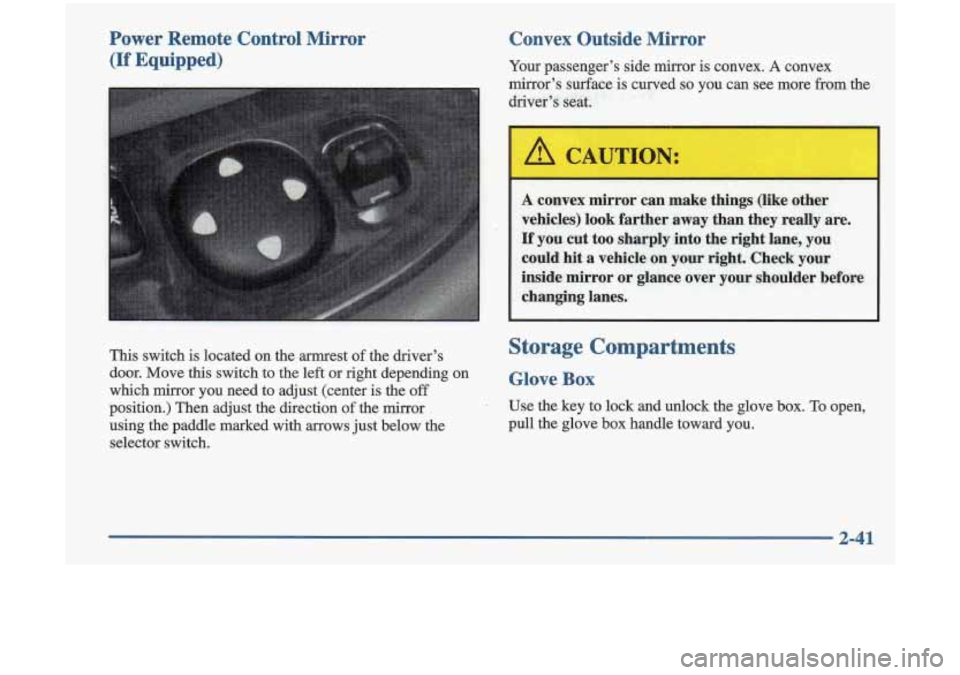
Power Remote Control Mirror
(If Equipped) Convex Outside Mirror Your
passenger’s side rnirror is convex. A convex
mirror’s surface
is curved so you can see more from the
diver’s seat.
A canvex mimor can make things (like other
vehicles)
look farther away thaa they really are.
If you cut too sharply into the right lane, you
could hit
a vehicle on your right. Check your
inside mirror or gl’ance over your shoulder before changing lanes.
This switch is located on the armrest of the driver’s
door. Move
this switch to the left or right depending on
which mirror you need to adjust (center
is the off
position.) Then adjust the direction of the mirror
using the paddle marked with
arrows just below the
selector switch.
Storage ComDartments
Glove Box
Use the key to lock and unlock the glove box. To open,
pull the glove box handle toward you.
2-41
Page 108 of 348

Sunvisors
To block out glare, you cm swing down the visors. You
can also swing them to the side.
Visor Vanity Mirror
Lift the cover to expose the visor vanity mirror.
Illuminated Visor Vanity Mirror
(If Equipped)
This mirror is located on the passenger's side visor.
When you
lift the cover, the light will turn on.
:! .,.I ., 1J .'I
Accessory Power Outlets
Your vehicle is equipped with two accessory power
outlets. There
is one located at the front of the center
console and one located on the passenger's side
of the
center console. You can
use
it to pfug in additional electric accessories.
Be sure
to follow the proper installation instructions that
are included with any electrical accessory you install.
The accessory power outlets
are protected by a fuse and
have a maximum current level.
Pull down on the outer ring
to use the garment hook.
2-44
Page 160 of 348
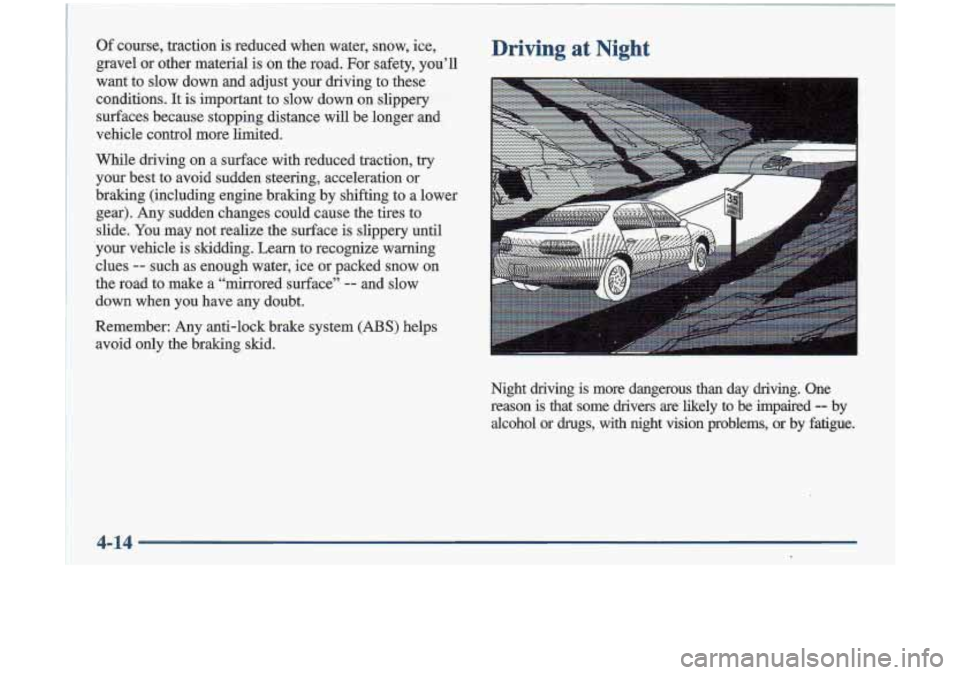
Of course, traction is reduced when water, snow, ice, Driving at Night
gravel or other material is on the road. For safety, you’ll
want to slow down and adjust your driving to these conditions.
It is important to slow down on slippery
surfaces because stopping distance will be longer and
vehicle control more limited.
While driving on a surface with reduced traction, try
your best to avoid sudden steering, acceleration
or
braking (including engine braking by shifting to a lower gear). Any sudden changes could cause the tires to
slide.
You may not realize the surface is slippery until
your vehicle is skidding.
Learn to recognize warning
clues
-- such as enough water, ice or packed snow on
the road to make a “mirrored surface”
-- and slow
down when you have any doubt.
Remember: Any anti-lock brake system
(ABS) helps
avoid only the braking skid.
Night
driving is more dangerous than day driving. One
reason
is that some drivers are likely to be impaired -- by
alcohol
or drugs, with night vision problems, or by fatigue.
4-14
I
Page 161 of 348
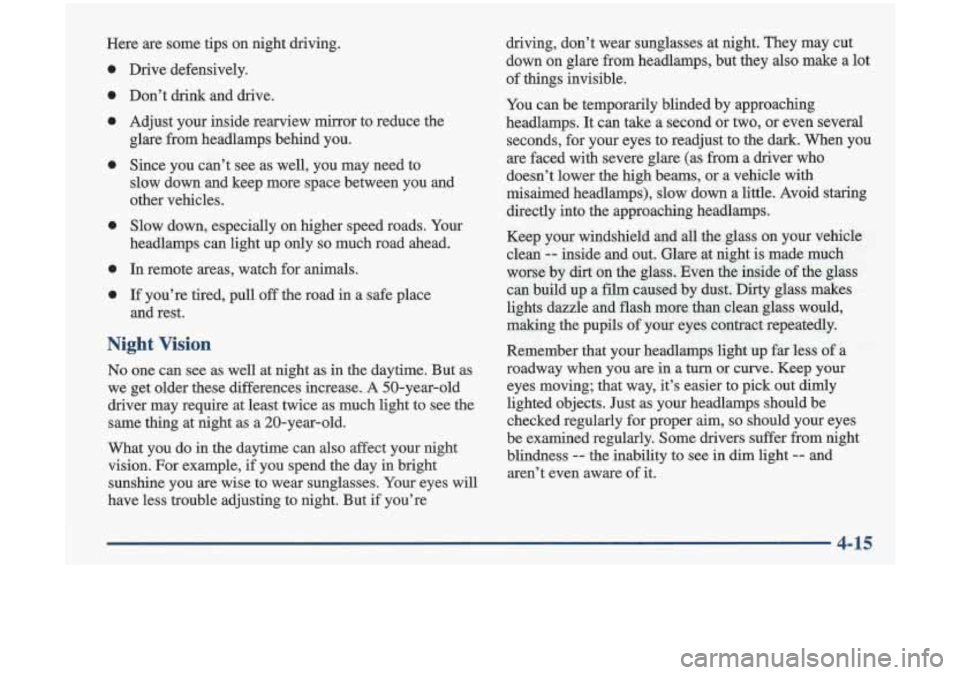
Here are some tips on night driving.
0
0
0
0
0
0
0
Drive defensively.
Don’t drink and drive.
Adjust
your inside rearview mirror to reduce the
glare from headlamps behind you.
Since you can’t see as well, you may need to
slow down and keep more space between you and
other vehicles.
Slow down, especially on higher speed roads. Your
headlamps can light up only so much road ahead.
In remote areas, watch for animals.
If you’re tired, pull off the road in a safe place
and rest.
Night Vision
No one can see as well at night as in the daytime. But as
we get older these differences increase. A 50-year-old
driver may require at least twice
as much light to see the
same thing at night as a 20-year-old.
What
you do in the daytime can also affect your night
vision. For example, if you spend the day in bright
sunshine you are wise to wear sunglasses.
Your eyes will
have less trouble adjusting to night. But
if you’re
4-15
Page 166 of 348
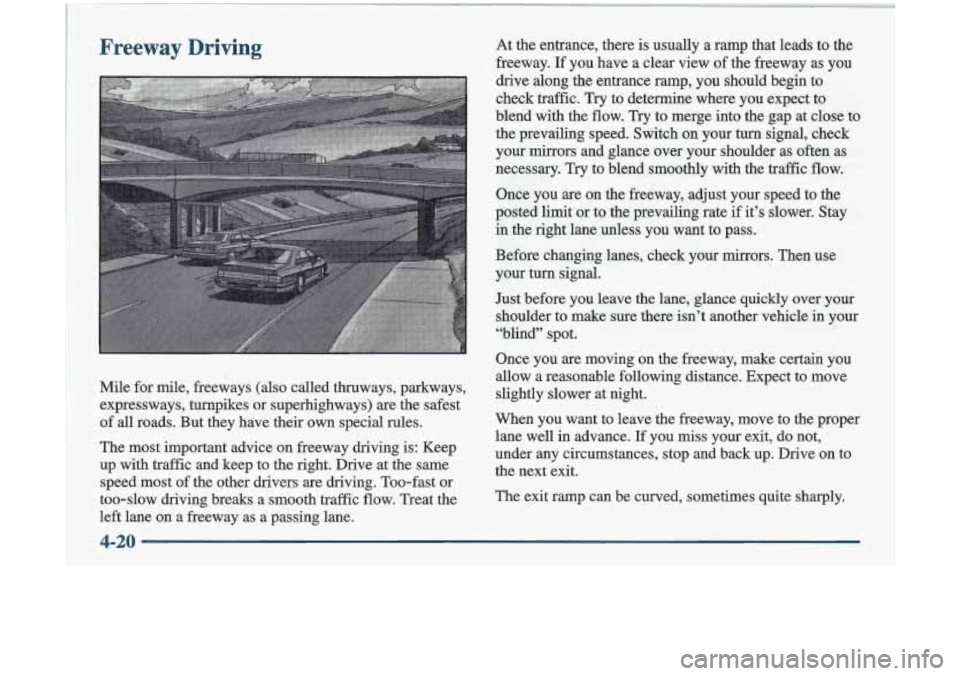
Freeway Driving
Mile for mile, freeways (also called thruways, parkways,
expressways, turnpikes or superhighways) are the safest of all roads. But they have their own special rules.
The most important advice on freeway driving is: Keep
up with traffic and keep to the right. Drive at the same
speed most of the other drivers are driving. Too-fast or
too-slow driving breaks a smooth traffic flow. Treat the
left lane on a freeway as a passing lane. At the entrance, there
is usually
a ramp that leads to the
freeway.
If you have a clear view of the freeway as you
drive along the entrance ramp, you should begin to
check traffic.
Try to determine where you expect to
blend with the flow. Try
to merge into the gap at close to
the prevailing speed. Switch on your
turn signal, check
your mirrors and glance over your shoulder as often as
necessary. Try
to blend smoothly with the traffic flow.
Once you are on the freeway, adjust your speed to the
posted limit or to the prevailing rate if it’s slower. Stay
in the right lane unless you want to pass.
Before changing lanes, check your mirrors. Then use
your
turn signal.
Just before you leave the lane, glance quickly over your
shoulder to make sure there isn’t another vehicle in
your
“blind” spot.
Once you are moving
on the freeway, make certain you
allow a reasonable following distance. Expect to move
slightly slower at night.
When you want
to leave the freeway, move to the proper
lane well in advance.
If you miss your exit, do not,
under any circumstances, stop and back up. Drive on to
the next exit.
The exit ramp can be curved, sometimes quite sharply.
4-20
Page 168 of 348

Highway Hypnosis
Is there actually such a condition as “highway hypnosis”?
Or is it just plain falling asleep at the wheel? Call it
highway hypnosis, lack of awareness, or whatever.
There is something about
an easy stretch of road with
the same scenery, along with the hum
of the tires on the
road, the drone of the engine, and the rush of the wind
against the vehicle that can make you sleepy. Don’t let it
happen to you! If it does, your vehicle can leave the
road in
less than a secund, and you could crash and
be injured.
What can you do about highway hypnosis? First, be aware that it can happen.
Then here are some tips:
Make sure your vehicle is well ventilated, with a
comfortably cool interior.
Keep your eyes moving. Scan the road ahead and to
the sides. Check your rearview mirrors and your
instruments frequently.
If you get sleepy, pull off the road into a rest, service
or parking area and take a nap, get some exercise, or
both. For safety, treat drowsiness
on the highway as
an emergency.
Hill and Mountain Roads
Driving on steep hills or mountains is different from
driving in flat or rolling terrain.
4-22
Page 274 of 348

e '4
A, RDO ACC B. WIPER MICRO 1- C. TRUNK
D. TURN LPS
REURFA E. PWFi MIRROR F. AIR BAG G. BFC BAT H. PCM ACC J. DR LOCK
K. IPC/BFC ACC CIRCUIT
PWRSEATS 0
010 OH
MICRO
DR UNLOCK
DR LOCK DR UNLOCK DRIVERS
STOP HWD IPCMVAC LPS LPS BA7T , , -- . ..
Usage
Radio
Wipers Trunk Release and Remote Lock Control
Turn Signals
Power Mirrors
Air Bag
HAZARD LPS
IPCIHVAC BATT
MICRO RELAY
TRUNKREL
CIRCUIT BRKR
PWR SEATS
MICRO RELAY DR UNLOCK
MICRO RELAY DR LOCK
MICRO RELAY
DRIVERS DR
UNLOCK
Usage
Body Function Control~Module
Powertrain Control Module
Door Locks
Body Function Control
Module, Cluster
Stoplamps
Hazard Lamps
Cluster, Climate Control
Remote Trunk Release Power Seats
Door Locks
Door Locks
Not Used
6-54
Page 276 of 348
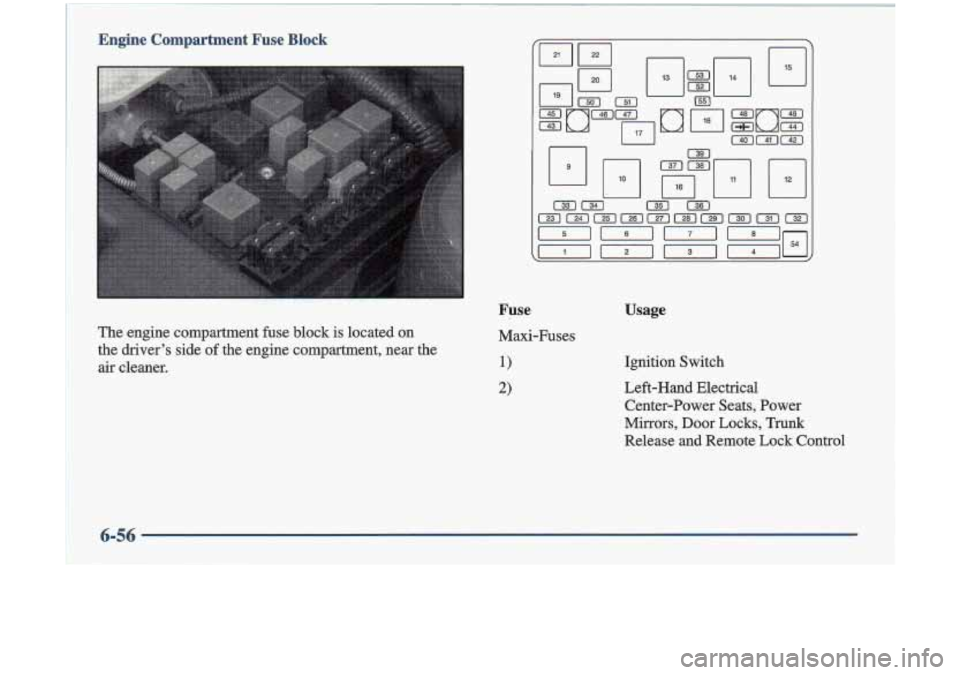
Engine Compartment Fuse Black
I .5d I
The engine compartment fuse block is located on
the driver's side
of the engine compartment, near the
air cleaner.
Fuse
Maxi-Fuses
1)
2)
Usage
Ignition Switch
Left-Hand Electrical
Center-Power Seats, Power
Mirrors,
Door Locks, Trunk
Release and Remote Lock Control
6-56